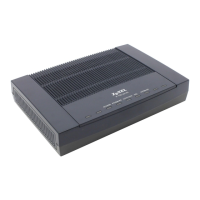Chapter 22 QoS
IES4005M User’s Guide
157
performance and make the network inadequate for delay-sensitive applications such as VoIP or
video-on-demand (VOD).
Configure QoS to prioritize downstream traffic in queues and fine-tune network performance.
• QoS applies only to the downstream traffic (traffic going to the subscribers).
• QoS limits the data rate of traffic flowing through the IES’s physical queues.
Queuing
Queuing is used to help solve performance degradation when there is network congestion. The
switch has eight physical queues, Q0 to Q7. Q7 has the highest priority and Q0 has the lowest.
Queuing algorithms allow switches to maintain separate queues for packets from each individual
source or flow and prevent a source from monopolizing the bandwidth.
• Strictly Priority Queuing (SPQ) services queues based on priority only. As traffic comes into the
IES, traffic on the highest priority queue, Q7 is transmitted first. When that queue empties,
traffic on the next highest-priority queue, Q6 is transmitted until Q6 empties, and then traffic is
transmitted on Q5 and so on. If higher priority queues never empty, then traffic on lower priority
queues never gets sent. SP does not automatically adapt to changing network requirements.
• Weighted Fair Queuing is used to guarantee each queue's minimum bandwidth based on its
bandwidth weight (portion) (the number you configure in the Weight field) when there is traffic
congestion. WFQ is activated only when a port has more traffic than it can handle. Queues with
larger weights get more guaranteed bandwidth than queues with smaller weights. This queuing
mechanism is highly efficient in that it divides any available bandwidth across the different traffic
queues. The default weight for each queue is 50.
• Weighted Round Robin Scheduling (WRR) scheduling services queues of the same priority level
on a rotating basis based on their queue weight. The higher a queue’s weight, the more service it
gets. This queuing mechanism is highly efficient in that it divides any available bandwidth across
the different traffic queues and returns to queues that have not yet emptied.
The following table describes commonly used parameter notation for these commands.
Table 108 Physical Queue Priority
QUEUE PRIORITY
Q7 8 (Highest)
Q6 7
Q5 6
Q4 5
Q3 4
Q2 3
Q1 2
Q0 1 (Lowest)
Table 109 QoS Command Parameters
NOTATION DESCRIPTION
rate
The maximum rate. 32-100000 in kbps. Default 100000.
name
Name of a profile. Use up to 31 printable characters.
depth
The maximum number of packets, 30-255, default 255

